5 Antiviral herbs to combine in a tincture and boost your immune system. It combines the beneficial properties of echinacea tincture and elderberry tincture with antiviral herbs to ward off illness.
Do you catch every cold or bug that’s going around? That’s the story in many families when the kids go back to school. That combination of early alarms, late nights, community exposure to viruses, and lack of natural sunlight and vitamin D combine to weaken our immune systems and weakens our immunity so that we are prime targets for the next bug that’s going around.
Rather than be the victim try these 5 antiviral herbs that can strengthen your immunity and stop viruses from replicating in your body. Even if you do get sick these five antiviral herbs are known to lessen the duration of a cold or flu and lessen the severity of the symptoms.
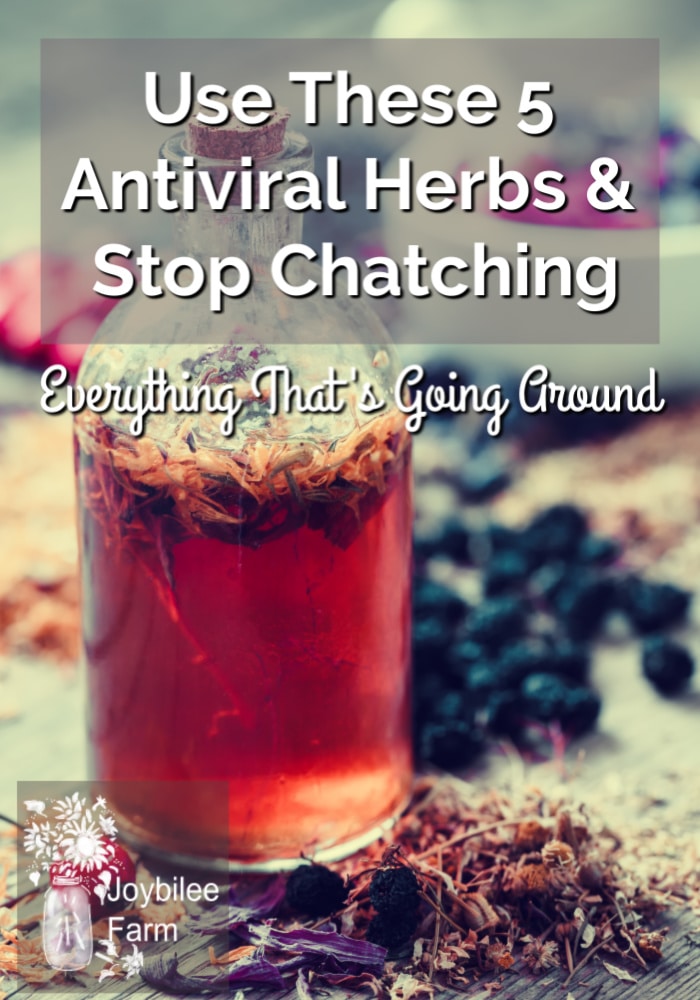
Echinacea Tincture
Echinacea is a native North American plant and is indigenous to the prairies and central plains. This gorgeous perennial is easy to grow in zones 3 to 9 and is traditionally known for its antiviral and immune boosting properties. Its also loved by bees and butterflies making it a superb addition to your flower beds and herb garden.
According to Dr. Michael Tierra, Founder of the American Herbalist Guild, Echinacea purpurea root is the best herbs for blood and lymph purification, as it neutralizes acid conditions in the blood associated with lymphatic stagnation.
Echinacea tincture is effective in the prevention and easing of colds and flu symptoms. Use the above-ground parts including flowers and leaves, or just use the roots alone. The key to effective echinacea tincture is to use the herbs as close to harvest time as possible. Dried and in storage, the effectiveness rapidly diminishes, so that herbs stored for 6 months are greatly diminished in potency.

Elderberries
Black and Blue elderberries (Sambucus canadensis, Sambucus nigra, or Sambucus glauca) grow wild throughout most of the USA and in the southern part of Canada. They are hardy from zone 2 to 11 and prefer moist soil in open areas. In freshly logged areas and beside stream banks, you’ll find elder growing and colonizing on its own. Elder can be grown from seed and in places where elderberry is already established baby elder bushes spring up anywhere that birds spread the seed.
The elderberry has a unique tart taste for distinctive jams, jellies, and syrups. But it’s a real star when it comes to aiding in the treatment of the common cold, or the flu. The berries are high in antioxidants and have more anthocyanins than blueberries. The berries make excellent home-made wine, mead, and winter cordial. An ounce taken just before going to bed is an old-fashioned and well-established cure for a cold.
The addition of elderberries to this antiviral herbs tincture will dramatically boost your immune system.
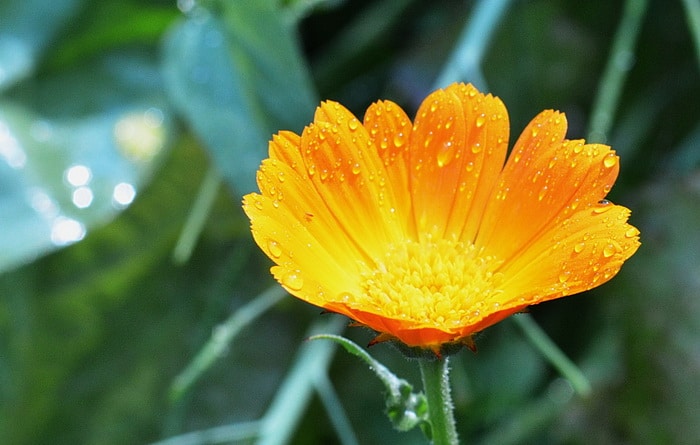
Calendula Flowers
Calendula is a hardy cool-weather annual. Plant the seeds in the ground about 2 weeks before your last frost date, they will begin peaking out as soon as the ground warms. Starts will begin to bloom about 8 weeks later and continue to give you flowers to harvest for a few weeks after frost. If you live in a warm-weather location, the plants will not produce during the hottest part of the summer but will continue to bloom well into the fall.
Calendula flowers are antiviral, antibiotic, and anti-inflammatory. Known for their skin healing properties and their ability to reduce scarring, they are rich in antioxidants and carotenoids to help the body fight bacterial infections and viruses.
There are several ways to preserve the goodness of calendula blossoms. Drying the blossoms is the easiest way, but dried flowers last for only a year or two. By preserving it in other ways, you can extend this shelf life to 5 years or more.
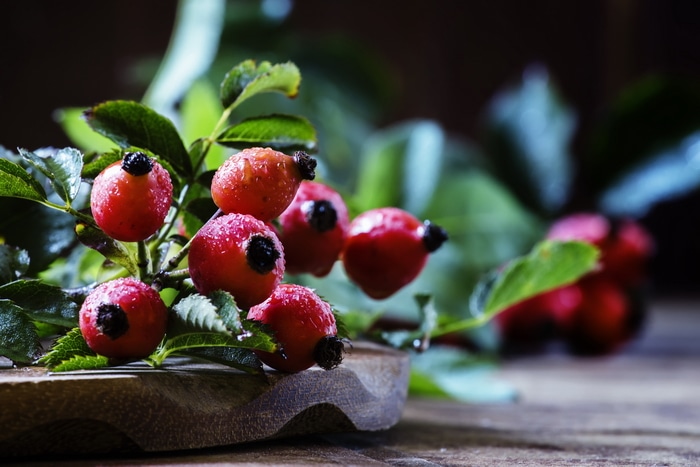
Rosehips for Vitamin C
Rose hips are rich in vitamin C, one of the highest plant sources, with 100 grams of dried hips yielding 2,000 mg of vitamin C. Rosehips contain vitamin A and B and the antioxidant lycopene, also found in tomatoes. Rosehips are also anti-inflammatory, immune-boosting, and anti-oxidant, making them beneficial for the treatment of arthritis, colds, and flu.
Their benefits can be gained by using them in tea, adding the dried, powdered fruit to baking, making syrup, or adding them to a tincture of antiviral herbs.
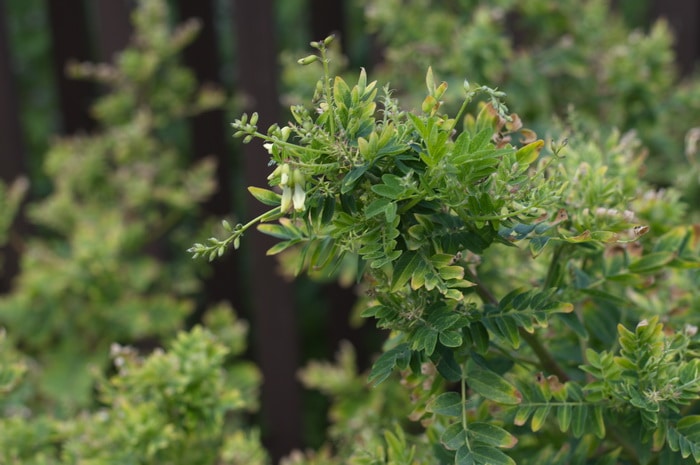
Astragalus Root
Grown in USDA hardiness zones 5 to 9, this perennial from the pea family can be found growing wild in dry sandy soils, mountain thickets, meadows, and coniferous forests.
It is also well adapted to your home garden.
The major components of Astragalus membranaceous are polysaccharides, flavonoids, and saponins. Contemporary use of Astragalus membranaceous mainly focuses on its immunomodulating, anti-oxidant, and anti-inflammatory, as well as its anticancer effects. [source]
Traditionally astragalus (Astragalus membranaceous) is used in combination with other herbs to support the immune system. It is commonly used in traditional Chinese medicine to treat hepatitis and as an adjunct therapy to cancer, it’s known as Huang Qi.
In the United States, it’s called Milk Vetch and is considered an adaptogen that boosts the body’s immune system and protects you against the effects of stress. It is often used in combination with other antiviral and antibacterial herbs to prevent or lessen the severity of colds and flu.
Print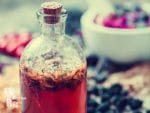
Antiviral Herbs Tincture for Cold and Flu Relief
- Prep Time: 10 minutes
- Total Time: 10 minutes
- Yield: 1 pint 1x
- Method: Tincture
Description
This combination of five antiviral herbs provides the best immune booster you can make at home. All ingredients can be grown in your garden and dried for home use or purchased from a reliable bulk herb provider.
Ingredients
- 1/2 cup echinacea purpurea herb and root
- 1 cup elderberries
- 1/4 cup calendula flowers, dried
- 1/4 cup rosehips, dried and deseeded
- 1/4 cup astragalus root, dried
- 3 cups Brandy
- A wide-mouth quart canning jar
- A stainless steel funnel
- A stainless steel strainer
- Cotton cloth or cheesecloth for pressing out the herbs
Instructions
- Wash and sanitize your equipment.
- Place all the herbs in a jar up to 1/2 full. The dried herbs will absorb the alcohol and swell in the jar.
- Use a chopstick to displace any air bubbles. After 48 hours, take a look at the jar and top it up with more brandy to keep herbs submerged.
- Cap tightly and label the jar with the contents and the date. Don’t forget to label, in a month you may not remember what you put in the jar and it will look entirely different.
- Every day or as often as you think of it, shake the jar to evenly distribute the herb in the alcohol.
- After 4 to 6 weeks your tinctures are ready to strain.
To use:
For Adults: Use 1 teaspoon every 2 hours at the first signs of a cold or flu.
For Children under 15: Use 1/2 teaspoon every 2 hours at the first signs of a cold or flu.
For Children under 5: Use 1/4 teaspoon every 2 hours at the first signs of a cold or flu.
Use with caution for children under 2.
Notes
To strain the herb tincture, line a fine-mesh sieve with a cloth. Place the sieve over a glass bowl to catch the liquid. Once most of the tincture has dripped through the cloth into the bowl, twist up the cloth to squeeze out as much tincture as possible.
Pour the tincture into colored glass bottles. Label and store in a cool, dry, dark cupboard. Tinctures made with alcohol and dried herbs have a long shelf life. They can last for decades without a decrease in potency, provided they are protected from light and heat.

Antiviral Herbs Tincture Recipe
This combination of five antiviral herbs provides the best immune booster you can make at home. All ingredients can be grown in your garden and dried for home use or purchased from a reliable bulk herb provider.
Ingredients:
- 1/2 cup echinacea purpurea herb and root
- 1 cup elderberries
- 1/4 cup calendula flowers, dried
- 1/4 cup rosehips, dried and deseeded
- 1/4 cup astragalus root, dried
- 3 cups Brandy
- A wide-mouth quart canning jar
- A stainless steel funnel
- A stainless steel strainer
- Cotton cloth or cheesecloth for pressing out the herbs
Method:
- Wash and sanitize your equipment.
- Place all the herbs in a jar up to 1/2 full. The dried herbs will absorb the alcohol and swell in the jar.
- Use a chopstick to displace any air bubbles. After 48 hours, take a look at the jar and top it up with more brandy to keep herbs submerged.
- Cap tightly and label the jar with the contents and the date. Don’t forget to label, in a month you may not remember what you put in the jar and it will look entirely different.
- Every day or as often as you think of it, shake the jar to evenly distribute the herb in the alcohol.
- After 4 to 6 weeks your tinctures are ready to strain.
To strain the herb tincture, line a fine-mesh sieve with a cloth. Place the sieve over a glass bowl to catch the liquid. Once most of the tincture has dripped through the cloth into the bowl, twist up the cloth to squeeze out as much tincture as possible.
Pour the tincture into colored glass bottles. Label and store in a cool, dry, dark cupboard. Tinctures made with alcohol and dried herbs have a long shelf life. They can last for decades without a decrease in potency, provided they are protected from light and heat.
To use:
For Adults: Use 1 teaspoon every 2 hours at the first signs of a cold or flu.
For Children under 15: Use 1/2 teaspoon every 2 hours at the first signs of a cold or flu.
For Children under 5: Use 1/4 teaspoon every 2 hours at the first signs of a cold or flu.
Use with caution for children under 2.
Ginger for Colds and Flu
If you don’t have time to wait 30 days for this anti-viral herbal tincture to steep, ginger might be as close as your kitchen spice cupboard. Ginger is a superb and easy to find herb that can increase circulation, aid digestion, and relieve many symptoms of the common cold or the flu. If you need an herbal remedy for cold and flu season and you need it right now, Ginger, will meet you where you are at.
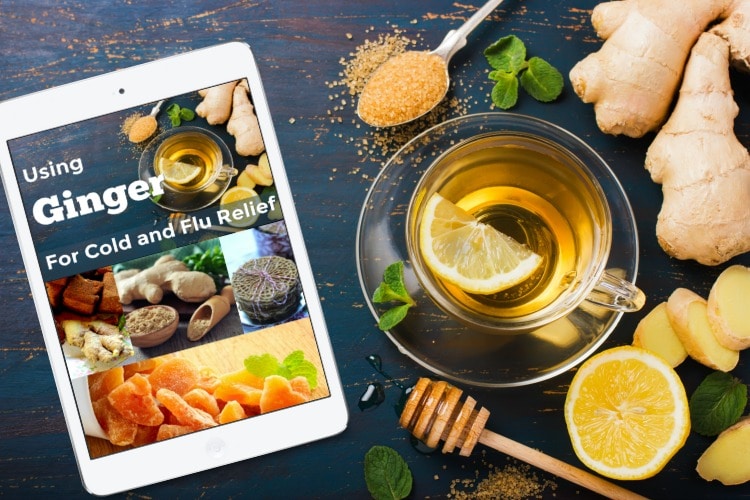
Grab my FREE ebook, “Using Ginger for Cold and Flu Relief” and get the help you need tonight. Tomorrow gather the five antiviral herbs and get your Anti-viral tincture started. Tonight mix up an easy ginger drink for quick relief of the aches and pains, sore throat, and the general unwell feelings from the common cold.



I’d suggest phoning Mountain Rose Herb or another herb supplier and ask how old their echinacea root is.
Hi, any recommendations on where to find the less than 6 month old echinacea root, if unable to grow it? thanks
Thank you for pointing that out. I’ve added the information to the post.
I love the sound of this recipe, but the how to use an dhow much has been left out? Also, are the elderberries and echinacea dry as well or fresh?
How much and how often do you use? How much Do you use as preventative vs during illness?